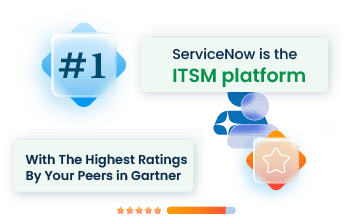“Are siloed IT processes and sluggish issue resolution hindering your business growth? Manual ticketing systems lead to costly delays, dissatisfied customers, and missed opportunities.
ServiceNow’s Ticketing System revolutionizes IT service management, consolidating processes, automating workflows, and ensuring swift issue resolution. Empower your team with a single platform to streamline incident management, optimize resource allocation, and enhance customer satisfaction. Elevate your IT operations and drive business success with ServiceNow.
In this blog, we’ll explore how ServiceNow’s Ticketing System can transform your IT operations and empower your organization to achieve its full potential.
What is a ServiceNow Ticketing System?
A ServiceNow Ticketing System is a tool that helps manage and track IT service requests and incidents, making IT operations more efficient and effective.
The main job of the ServiceNow Ticketing System is to log, track, and manage IT issues from start to finish. When an incident or service request happens, it is recorded as a ticket. This ticket is then assigned to the right IT personnel, who work on resolving the issue. The system ensures no ticket is overlooked and all issues are addressed promptly.
By automating and organizing IT request management, the ServiceNow Ticketing System greatly improves business efficiency. Automated workflows reduce the time spent on manual tasks, allowing IT teams to focus on more important initiatives. This also helps reduce errors and ensures requests and incidents are handled consistently.
The ServiceNow Ticketing System offers valuable data and insights through its reporting and analytics features. These insights help IT managers and business leaders understand trends, identify recurring issues, and make informed decisions to improve IT services. With real-time data, businesses can address potential problems before they grow, leading to better overall performance and strategic planning.
Why Do You Need a ServiceNow Ticketing System?
A ticketing system helps businesses streamline IT operations and improve efficiency. Here are key reasons for implementing one:
Cost Savings
A ticketing system like ServiceNow reduces costs by automating routine tasks and optimizing resource use. Quick resolution of IT issues minimizes downtime, preventing productivity and revenue losses.
Operational Efficiency
ServiceNow centralizes all IT service requests, incidents, and problems on one platform. This allows IT teams to handle multiple issues simultaneously, ensuring faster response times. Streamlined workflows and automation further boost productivity, letting IT staff focus on strategic tasks.
Enhanced Decision-Making
ServiceNow offers comprehensive reporting and analytics, providing valuable insights into IT performance. Decision-makers can access real-time data to identify trends, assess efficiency, and make informed choices. This leads to better strategic planning and improved service delivery.
Key Features of the ServiceNow Ticketing System
ServiceNow’s ticketing system offers a variety of features that cater to the needs of executives and managers. These include:
- Incident Management: Automatically log, track, and resolve incidents to reduce downtime.
- Problem Management: Identify and address the root causes of recurring issues to prevent future problems.
- Request Management: Handle service requests efficiently, ensuring timely fulfillment.
- Change Management: Manage changes in the IT environment with minimal disruption.
Customization and integration capabilities allow the system to adapt to specific business needs. ServiceNow integrates seamlessly with other enterprise systems, creating a unified IT environment that improves overall efficiency.
ServiceNow enhances service delivery and operational efficiency. By automating routine tasks, the system reduces manual effort, freeing up IT staff for more strategic initiatives. Comprehensive reporting tools provide insights into IT performance, helping decision-makers identify areas for improvement and optimize resource allocation.
Setting up ServiceNow’s ticketing system involves several strategic steps:
- Define Objectives: Identify the specific needs and goals of your business to tailor the system accordingly.
- Configure the System: Customize workflows, forms, and dashboards to match your business processes.
- Integrate with Existing Systems: Ensure seamless integration with other enterprise systems for a unified IT environment.
- Train Your Team: Provide comprehensive training to ensure your team can effectively use the system.
- Monitor and Optimize: Continuously monitor performance and make adjustments to optimize the system’s effectiveness.
How to Use the ServiceNow Ticketing Tool
Creating, Managing, and Resolving Tickets
Using the ServiceNow ticketing tool involves several key steps to efficiently manage IT issues. Here’s a simple guide to help you through the process.
Creating Tickets
- Log In: Access the ServiceNow dashboard with your credentials.
- New Ticket: Click on “Create New” or “New Incident” from the main menu.
- Enter Details: Fill in the required fields such as incident type, description, priority, and any additional relevant information.
- Submit: Once all details are entered, click “Submit” to log the ticket into the system.
This process ensures all incidents are properly recorded, allowing for better tracking and faster resolution.
Managing Tickets
- View Tickets: Go to the “All Incidents” or “My Incidents” section to see a list of all logged tickets.
- Assign Tickets: Select an unassigned ticket and assign it to the appropriate team member or department.
- Update Status: Change the ticket status to “In Progress” once work begins. Keep updating the status as the issue progresses.
Effective ticket management helps prioritize and address critical issues promptly, improving overall efficiency.
Resolving Tickets
- Work on the Issue: Follow the steps needed to resolve the issue described in the ticket.
- Document the Resolution: Enter detailed notes on the steps taken to
Types of Tickets in ServiceNow
ServiceNow’s ticketing system efficiently handles various IT issues. Understanding these ticket types is key for effective IT service management.
ServiceNow CMDB: Real-Time Asset Views
Incident Management aims to restore normal service operations quickly. When an incident disrupts workflow, minimizing this disruption is essential. The steps include:
- Logging Incidents: Users report incidents, which are logged into the system.
- Prioritizing Incidents: Incidents are prioritized based on their impact and urgency.
- Resolving Incidents: The IT team resolves the issue promptly to restore service.
This process reduces downtime and improves user satisfaction by addressing issues quickly.
Problem Management
Problem Management identifies and eliminates the root causes of recurring incidents. By addressing these underlying issues, future incidents are less likely. The steps include:
- Problem Detection: Identifying problems through trend analysis of incidents.
- Root Cause Analysis: Investigating the root cause of problems.
- Implementing Solutions: Developing and applying solutions to prevent recurrence.
Effective problem management improves long-term IT service quality and stability.
Request Management
Request Management handles service requests from users, such as access to applications, password resets, or hardware installations. The steps include:
- Submitting Requests: Users submit requests through the ServiceNow portal.
- Approving Requests: Requests are reviewed and approved based on predefined criteria.
- Fulfilling Requests: The IT team fulfills the requests, ensuring users receive the services they need.
This process streamlines handling routine service requests, enhancing operational efficiency.
Change Management
Change Management ensures changes to the IT environment are made systematically and with minimal disruption. This process maintains stability while implementing new features or updates. The steps include:
- Planning Changes: Identifying the need for changes and planning their implementation.
- Assessing Risks: Evaluating potential risks and impacts of the changes.
- Implementing Changes: Executing the changes in a controlled manner.
- Reviewing Changes: Post-implementation reviews to ensure changes were successful and to address any issues.
Best Practices for Maximizing Efficiency with the ServiceNow Ticketing System
Efficiency and Productivity Tips
Maximizing efficiency with the ServiceNow Ticketing System involves using best practices to streamline operations and boost productivity. Here are key strategies:
- Automate Routine Tasks: Use ServiceNow’s automation features for repetitive tasks like ticket assignments, status updates, and notifications. This reduces manual work, minimizes errors, and speeds up resolutions.
- Integrate with Other Tools: Enhance ServiceNow by connecting it with other enterprise tools such as monitoring systems, CRM platforms, and communication tools. This ensures seamless data flow and better coordination across departments.
- Customize Workflows: Adapt workflows to match your organization’s specific processes. Custom workflows help manage tickets more efficiently and ensure proper steps are followed for different issues.
- Utilize Dashboards and Reports: Use ServiceNow’s reporting and dashboard features to gain insights into IT performance. Regularly review these reports to identify bottlenecks, track resolution times, and measure efficiency.
- Prioritize Training: Make sure your IT team is well-trained in using ServiceNow. Regular training sessions help staff stay updated on new features and best practices, enabling more effective use of the system.
Tips on Automating Processes and Integrating with Other Tools
- Implement Workflow Automation: Set up automated workflows for common processes like incident management and service requests. This saves time and ensures consistency.
- Integrate with IT Monitoring Tools: Connect ServiceNow with IT monitoring tools to automatically create tickets for detected issues. This proactive approach helps address problems before they escalate.
- Sync with Communication Platforms: Integrate ServiceNow with tools like Slack or Microsoft Teams for instant updates and collaboration, speeding up resolutions.
- Use AI and Machine Learning: Implement AI-powered features like predictive analytics and virtual agents to handle routine inquiries and predict potential issues. This helps manage problems proactively and improve response times.
Integration Strategies
Integrating ServiceNow with other enterprise systems can greatly improve service delivery and business operations. Here are some key strategies:
- Seamless Data Flow: Connect ServiceNow with IT monitoring tools, CRM systems, and communication platforms. This integration ensures that data flows smoothly between systems, reducing manual data entry and minimizing errors.
- Unified IT Environment: Create a cohesive IT environment by integrating ServiceNow with your existing infrastructure. This allows for better coordination and more efficient problem-solving.
- Automated Workflows: Set up automated workflows that span multiple systems. For example, integrate ServiceNow with your email and notification systems to automatically inform stakeholders about ticket status updates.
Impact on Business Outcomes:
- Increased Productivity: Advanced automation and AI reduce the manual workload, allowing IT staff to focus on strategic initiatives.
- Cost Savings: Efficient processes and quick resolutions lower operational costs.
- Scalability: Optimized systems can easily scale with the growth of the business, maintaining performance and reliability.
Pros and Cons of the ServiceNow Ticketing System
Advantages
- Comprehensive Features: ServiceNow includes tools for incident, problem, request, and change management. These features help streamline IT operations and improve service delivery.
- Customization and Flexibility: The platform can be tailored to fit specific business needs. Custom workflows, dashboards, and reports ensure the system matches each organization’s processes.
- Integration Capabilities: ServiceNow integrates smoothly with other enterprise tools like CRM systems, IT monitoring tools, and communication platforms. This ensures smooth data flow and better coordination.
- Automation and AI: Advanced automation and AI features help reduce manual workload, speed up resolution times, and provide predictive insights for better decision-making.
- Scalability: The system can grow with the business, maintaining performance and reliability as the organization expands.
Disadvantages
- Complexity and Learning Curve: The extensive features and customization options can make the system complex and challenging to learn. It requires thorough training and support for effective use.
- Cost: ServiceNow can be expensive, especially for small to medium-sized businesses. Costs include licensing, implementation, customization, and ongoing maintenance.
- Over-Reliance on Customization: Too much customization can lead to maintenance challenges and increased complexity. Regular reviews and updates are needed to keep the system aligned with business needs.
- User Adoption: Users may resist adopting the system due to its complexity and the changes it brings to existing workflows. Comprehensive training and clear communication of benefits are essential to encourage adoption.
Conclusion
ServiceNow Ticketing System provides a strong solution for managing IT services. Key benefits include:
- Comprehensive ITSM Features: Manage incidents, problems, changes, and requests.
- Customization and Integration: Tailor workflows and integrate with other tools.
- Automation and AI: Reduce manual work and improve decision-making.
- Scalability: Grow with your business while maintaining performance.
Use best practices like automating workflows, integrating with existing tools, and customizing the platform to fit your needs.
Explore how ServiceNow can enhance your IT operations. Contact our team for a consultation and help with ServiceNow integrations.
We’d love to hear your thoughts! Comment below on how you think ServiceNow could benefit your organization.












